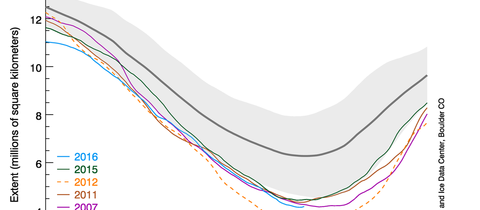Arctic Summer Sea Ice – Going Down, Down, Down
The vast, scrabbly sheath of sea ice drifting on the Arctic Ocean ended its annual summer retreat this week, and the result was sobering. This year tied with 2007 as having the second smallest ice extent ever recorded, the National Snow and Ice Data Centerannounced yesterday.
Of course the satellite record only goes back to 1979, seemingly leaving ample room for debate. As always, that resulted in enough interpretations and misinterpretations of Arctic conditions to suit just about anyone’s view.
But an important new study looking at Arctic change on longer time scales reinforces the unusual nature of the recent ice retreats. And another warns against jumping too quickly to predictions of wide open northern seas:
1) The long-term trend toward more open Arctic waters is the thing to watch, not year-to-year wiggles. (If the trend had a soundtrack, it would be Freddie King’s amazing “down, down, down, down” chorus from his 1971 hit.)
2) There’s persistent uncertainty about how long it will take to have a September with an ice-free Arctic Ocean. (That’s why I declined to take up a wager offered by a climate blogger a few years back.) How many scary predictions did you track over the last decade?
On the first point, a really remarkably new study, published online in Geographical Reviews last month, builds a robust estimate of sea ice conditions across the Arctic month by month from January 1850, the tail end of the “little ice age,” through 2013 by consolidating vast amounts of ice data from ship captains, military flights, coastal settlements and other sources.

I’d reported in years past on other such efforts but this data set is by far the most comprehensive — and significant. These lines from the abstract say why:
The consolidated database shows that there is no precedent as far back as 1850 for the 21st century’s minimum ice extent of sea ice on the pan-Arctic scale…. The rate of retreat since the 1990s is also unprecedented and especially large in the Beaufort and Chukchi Seas. Decadal and multidecadal variations have occurred in some regions, but their magnitudes are smaller than that of the recent ice loss. Interannual variability is prominent in all regions and will pose a challenge to sea ice prediction efforts.
I’d missed that paper until I read Brian Kahn’s helpful sea ice update for Climate Central yesterday. Kahn also led me to Zachary M. Labe of the University of California, Irvine, who created the captivating animation of the data from the paper. Here’s another way to see the trend:

On the second point, about predicting an open Arctic sea, a new study concludes that the chaotic nature of climate puts big fundamental limits — an irreducible two-decade-wide window — on efforts to forecast when the Arctic Ocean could be essentially free of ice in late summer. The study, published online Wednesday in Geophysical Research Letters, has a pretty straightforward title: “How predictable is the timing of a summer ice-free Arctic?”
The conclusion of the authors, from the University of Colorado, Boulder, and National Center for Atmospheric Research, is straightforward, as well:
Climate model simulations give a large range of over 100 years for predictions of when the Arctic could first become ice free in the summer, and many studies have attempted to narrow this uncertainty range. However, given the chaotic nature of the climate system, what amount of spread in the prediction of an ice-free summer Arctic is inevitable? Based on results from large ensemble simulations with the Community Earth System Model, we show that internal variability alone leads to a prediction uncertainty of about two decades, while scenario uncertainty between the strong (Representative Concentration Pathway (RCP) 8.5) and medium (RCP4.5) forcing scenarios [possible paths for greenhouse gas emissions] adds at least another 5 years.
The researchers also found no predictive value in seeking insights from trends in conditions like sea-ice thickness.
I reached out to the lead author, Alexandra Jahn, an assistant professor of atmospheric and ocean sciences at the University of Colorado, for a bit more:
[W]hat we hope to convey is that overly narrow predictions of the first time we’ll see an ice-free Arctic are not possible, as the climate system is chaotic and does not allow us to predict the occurrence of an event…with such precision. That is well known for weather forecasts, that we have a 10-day maximum window for forecasts, with more reliable forecasts for the next ~3 days. So nobody expects forecasters to be able to predict, for example, a white Christmas in September or even early December, but only a few days before Christmas. But for climate projections about an ice-free Arctic, we didn’t know how small or big that window was, and that’s what we looked at, and we showed that it this predictability window is 20 years, which is wider than maybe expected.
The bottom line, weighing the papers together?
The world is warming and Arctic sea ice is shrinking, more than it has in nearly two centuries. But don’t count on clarity in weighing when northern seas will be routinely be ice free.
Here’s a bit more context on this year’s ice minimum from the National Snow and Ice Data Center:
[W]eather over the Arctic Ocean this past summer has been generally stormy, cool, and cloudy—conditions that previous studies have shown to generally limit the rate of summer ice loss…. Why did extent fall to a tie for second lowest with 2007? The 2016 Arctic melt season started with a record low maximum extent in March, and sea ice was measured at record low monthly extents well into June. Computer models of ice thickness, and maps of sea ice age both indicated a much thinner ice pack at the end of winter.
Fonte: The New York Times



